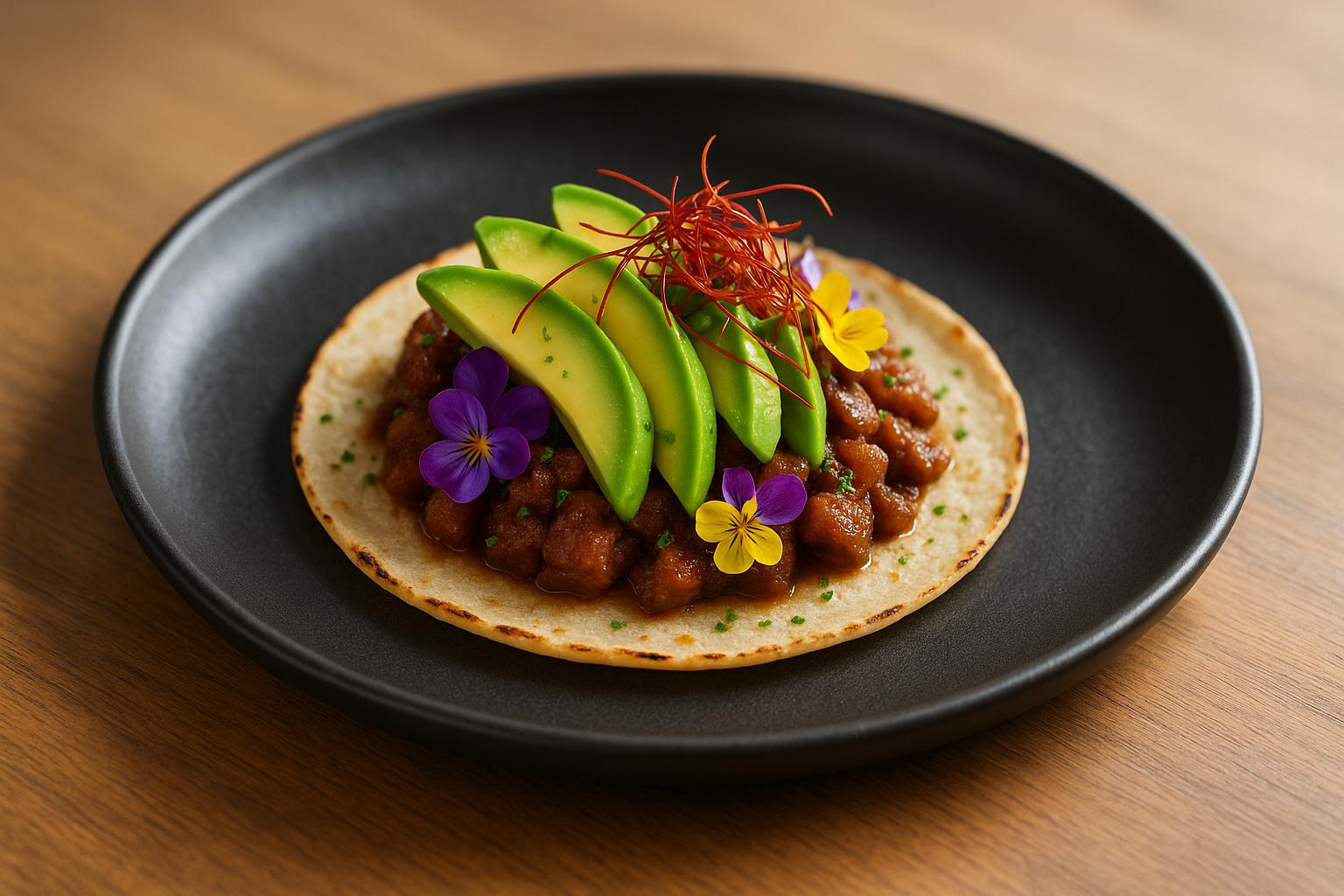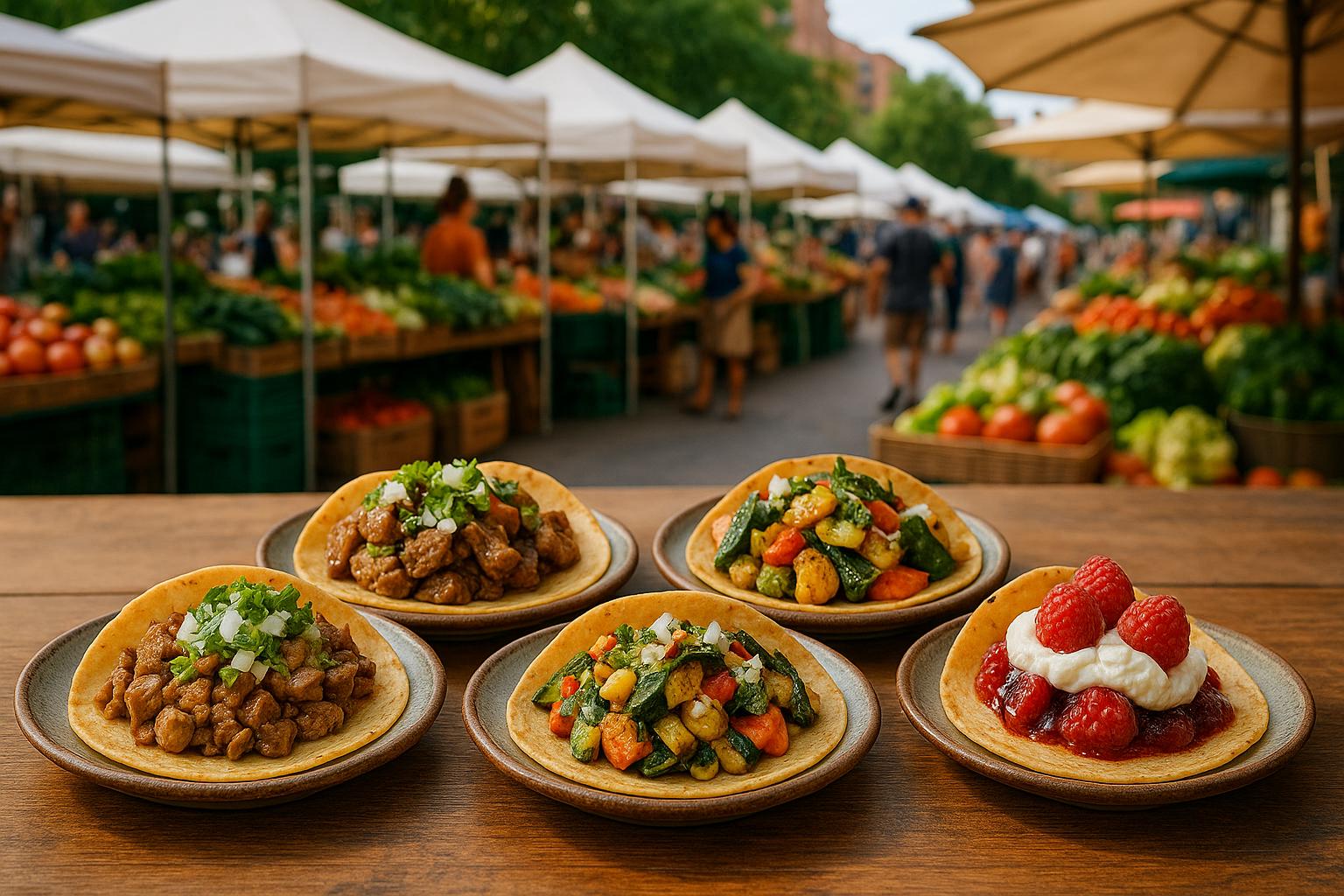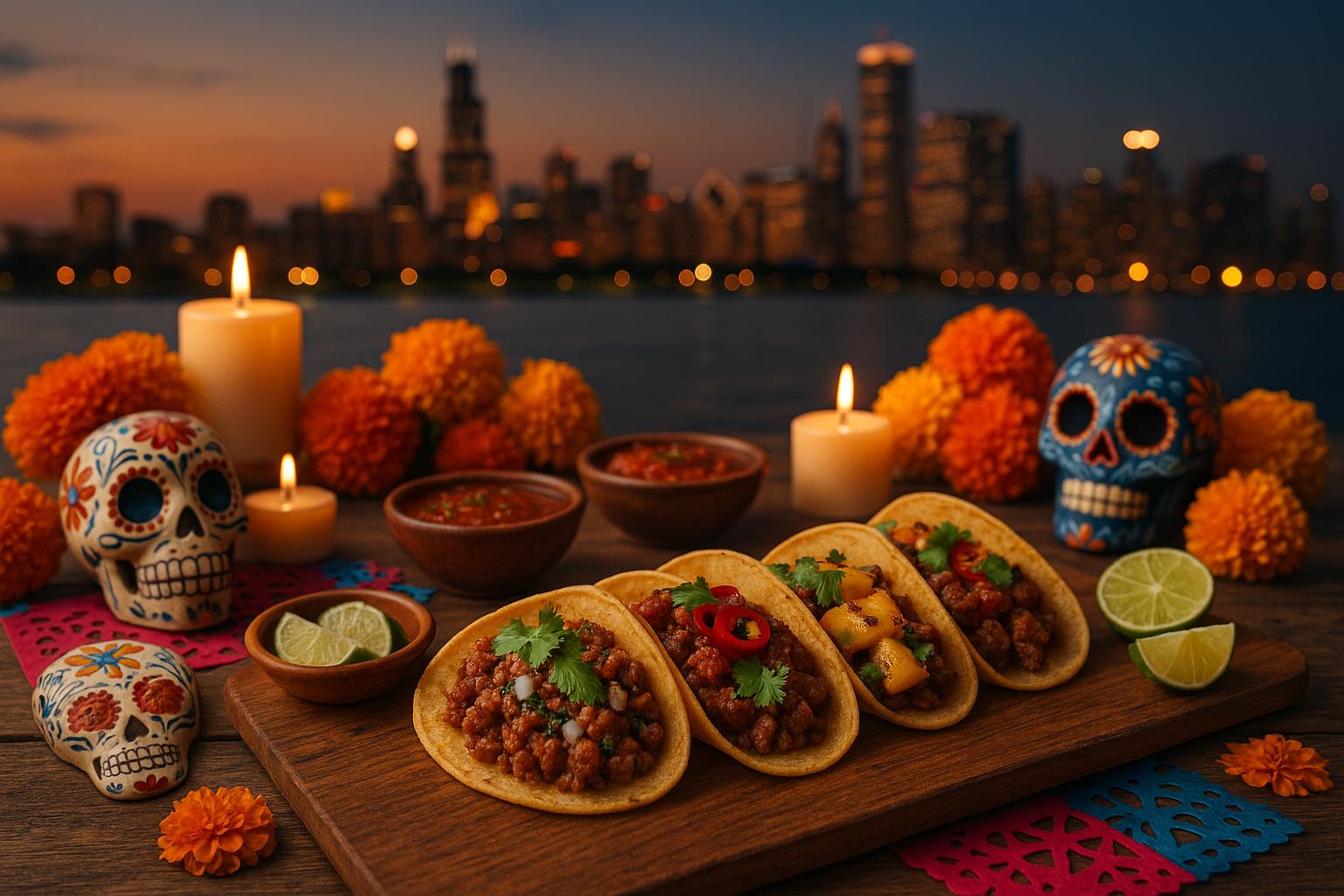Tacos in Chicago are more than just food - they’re a connection to heritage and family. With the second-largest Mexican population in the U.S., Chicago’s neighborhoods like Pilsen and Little Village are hubs for authentic recipes, family-run taquerías, and creative taco innovations. Here’s how families keep these traditions alive:
- Family Recipes: Passed down through generations, often learned by cooking side by side with grandparents.
- Neighborhood Taquerías: Places like Los Comales and Carnitas Uruapan serve as community anchors, preserving authentic flavors.
- Modern Touches: Families blend traditional methods with modern tools, like digitizing recipes and experimenting with new ingredients.
- Special Occasions: Tacos are central to celebrations like quinceañeras and holidays, often with DIY taco bars for gatherings.
Chicago’s taco culture thrives by honoring the past while adapting to the present, ensuring these traditions stay vibrant for future generations.
How Mexican Food Evolved in Chicago | No Passport Required with Marcus Samuelsson | Full Episode
Where Chicago's Taco Traditions Come From
Chicago's taco culture has deep roots tied to Mexican immigration, which introduced authentic recipes to the Midwest and shaped the city's culinary identity. This rich history gave rise to the family-run taquerías that continue to define Chicago's taco traditions today.
How Mexican-American Families Shaped Chicago's Taco Scene
The story of Chicago's tacos begins with Mexican families who brought their cherished recipes and culinary expertise to the city. In the early 1970s, as the demand for authentic Mexican food grew, these families began opening taquerías across Chicago.
One such pioneer was Camerino Gonzalez Valle, who founded Los Comales in Little Village. Frustrated by the lack of authentic Mexican food in Chicago, Camerino envisioned a taquería that catered to hardworking, blue-collar families. His daughter Christina recalls:
"He kept looking for Mexican restaurants, but there was nothing around, and he wanted a taqueria, which is a diner. It's a diner that specialized in quick casual fast food for the working man - blue collar family man - and that's what he replicated here." [3]
Los Comales quickly became a cornerstone of Chicago's taco scene, serving dishes like salted beef, beef cheek, and cow tongue tacos - flavors that were hard to find elsewhere. Camerino's legacy lives on through 16 Los Comales locations in Chicago, its suburbs, and Texas, all still family-operated or managed by former employees, even after his passing in 2021.
Another key figure was Ramon Reyes, who opened Birrieria Ocotlan on 87th Street and Commercial Avenue in 1973. He brought his family's birria recipe, dating back to 1926 in Ocotlan, Jalisco, to Chicago's South Side, creating a direct link between regional Mexican cooking and the city.
These family-run taquerías became more than just places to eat. They served as community hubs, offering jobs, support, and even help with amnesty applications. The cultural exchange between Chicago's Black and Latino communities also played a role in shaping the city's food scene. Food historian Jeffrey Pilcher explains:
"It's not at all surprising that in Chicago, where there is a large Black community and Mexican community going back decades, that there are food ties between those two communities. Food customs often get exchanged." [2]
These early efforts laid the groundwork for neighborhood hubs like Pilsen and Little Village, which are now synonymous with Chicago's taco culture.
Pilsen and Little Village: Neighborhood Food Centers
The neighborhoods of Pilsen and Little Village have become vibrant epicenters of taco culture, building on the legacies of these family-run taquerías. Pilsen, which became Chicago's first majority Latino neighborhood around 1970, is now home to the largest Mexican-American community in the Midwest [1] [4]. Walking down 18th Street, you'll encounter murals on historic masonry buildings, showcasing cultural and religious themes that reflect the neighborhood's rich heritage [5].
Little Village, or "La Villita", is another vital hub for taco traditions. Here, family-owned taquerías thrive, such as Carnitas Uruapan, which has been serving its signature pork dishes since 1975. The business processes an impressive 8,000 pounds of pork weekly, with most sales coming from takeout [1]. Similarly, Taqueria El Milagro, one of four taquerías tied to a local tortilla manufacturer founded in 1950, highlights the importance of regional specialties over broad menus [1].
The concentration of family-run taquerías in these neighborhoods has created a dynamic culinary scene. Food writer Mark Winters captures this sentiment:
"Part of my fascination with the tacos in Pilsen is just how specific they are, to a style or a particular region of Mexican cuisine... It's when you visit the longstanding storefronts that have been operating continuously - often with knowledge passed down from family member to family member - that you come to a realization that is blasphemous but true: Chicago's taco game blows Los Angeles' out of the water." [1]
These neighborhoods demonstrate how Chicago's taco traditions not only honor authentic recipes but also adapt to modern tastes, ensuring the city's taco culture remains both vibrant and deeply rooted in its history.
How Families Pass Down Taco Recipes
The essence of Chicago's taco traditions lies in how families preserve and share cherished recipes that carry memories, stories, and a deep sense of identity.
Culinary historian Sarah Lohman captures this beautifully: "Recipes rely on memory and feeling, instructions from an elder or a handwritten note. The history of your family's food is a way to access and preserve your ancestors' stories." [7] This emotional bond drives families to embrace both traditional and modern methods - like recording cooking sessions or using digital tools - to ensure their taco-making heritage endures. Here’s a closer look at how these traditions are kept alive.
Writing It Down and Going Digital
Chicago families are blending old-school approaches with modern tech to safeguard their taco recipes. Handwritten recipe cards often serve as the starting point, but many families now digitize these treasures. Tools like Google Sheets or Canva help create shared family cookbooks, while recipe-sharing apps make it easier to organize and store taco recipes, eliminating the clutter of paper cookbooks [11][12].
But preserving recipes isn’t just about writing them down; it’s also about learning through experience.
Cooking Side by Side with Grandparents
Cooking with grandparents is where the magic truly happens. These sessions - sometimes recorded for posterity - teach younger generations the hands-on skills needed to master taco-making [8]. There’s something special about learning by doing: touching the masa, smelling the spices, and tasting the flavors as they come together [10]. Grandparents guide each step, from mixing masa to seasoning meat and folding tacos, creating muscle memory that stays with you for life.
As Kate Walling puts it, "As we record the thoughts, ideas, and processes of our traditional family meals we create an heirloom that will be handed down to our children, grandchildren and great-grandchildren. We build a bridge by which our loved ones can learn about who we are, even after we are gone from this world." [6]
These sessions also become a time for storytelling. Families share the origins of recipes, food customs, and personal memories, adding layers of meaning to the process [9]. And when the tacos are finally served at family gatherings, they do more than satisfy hunger - they spark a desire to preserve these traditions, ensuring everyone feels connected to their roots [8].
sbb-itb-8621021
Tacos for Holidays and Special Events
In Chicago, tacos have become a staple of family gatherings, especially during holidays and milestone celebrations. These events are a time to honor traditional recipes while adapting them to meet the needs of modern families. Naturally, this approach extends to crafting special holiday menus.
Holiday Taco Meals
Chicago families have seamlessly incorporated tacos into their holiday traditions, blending old customs with new ones. Take Christmas Eve, for example - many households now enjoy fish tacos as a lighter, communal alternative to heavier holiday dishes [13].
Cinco de Mayo holds a special place in the city, thanks to its vibrant Mexican-American community. The day becomes a celebration of heritage, with families sharing cherished recipes and pairing them with homemade salsas and their favorite taco fillings [15].
To simplify the process for these gatherings, many families prepare marinades and slow-cooked meats ahead of time [19]. A well-rounded taco spread typically includes a variety of shells, proteins, toppings, and fresh salsas to cater to different tastes [19].
"When feeding a crowd, I have found that the more hands-on your guests are, the easier it is for the cook." – Heidi Potter, StyleBlueprint [20]
This advice is particularly useful for potluck-style gatherings, where guests bring their own ingredients to contribute to a collaborative taco-making experience [14]. Beyond the holidays, tacos also play a starring role in milestone celebrations.
Quinceañeras and Family Celebrations
Events like quinceañeras highlight how Chicago families balance traditional taco-making with contemporary needs [17]. Feeding large groups while accommodating various dietary preferences can be a challenge, but many families rise to the occasion with creative taco bars.
Cesar's in Lakeview offers a perfect example of this with their catering options tailored for Chicago celebrations. Their "Build-Your-Own Tacos" package features a taco bar complete with a variety of proteins and sides, while their "Family Taco Pack" provides 12 tacos with options like chicken, beef, pork, or barbacoa - ideal for smaller gatherings [16].
Birria tacos, with their rich, flavorful broth and tender meat, have also become a standout choice for special occasions, blending traditional recipes with a touch of modern flair [17].
To ensure a smooth dining experience, thoughtful planning is key. Arrange taco bars in a logical order - start with plates, then shells, followed by proteins, beans, rice, and finally toppings and sauces. Keep proteins warm and plan portions carefully to avoid running out [19] [20].
Delegating toppings to guests not only lightens the host's workload but also guarantees a diverse selection of flavors and spice levels, satisfying everyone from kids to heat-seekers [18]. Including both corn and flour tortillas ensures gluten-free options are available, making the celebration inclusive for all [18].
These gatherings are about more than just food - they’re a way for families to pass down culinary traditions and create lasting memories. By blending heritage with modern touches, Chicago families ensure that younger generations will continue to celebrate and adapt these traditions for years to come.
Updating Old Traditions for Today's Families
In Chicago, families are finding inventive ways to celebrate their taco heritage while keeping up with the demands of modern life. They’re striking a balance between preserving tradition and embracing contemporary conveniences.
New Recipe Ideas and Modern Ingredients
Families are getting creative in the kitchen, blending time-honored techniques with fresh, modern flavors. Local chefs are leading the way, showing how tradition and innovation can coexist beautifully [21].
Take Jonathan Zaragoza of Birrieria Zaragoza, for example. In 2018, this Rising Star Chef started crafting dishes that merge classic and modern approaches. His creations include tacos featuring roasted beets with mole amarillo, marcona almonds, chapuline vinaigrette, fennel, fermented radish, and goat's milk feta.
"As a proud Mexican, if somebody can bring my food, my culture to the forefront, if they can do that for Mexican food in Chicago, that's a win." [22]
Similarly, Diana Dávila of Mi Tocaya Antojeria in Logan Square has reimagined traditional Pueblan chiles en nogado. Her version, pork albondigas en nogado, features a pecan-Sherry sauce, charred shishitos, and candied cranberries. These inventive takes on classic dishes highlight the enduring richness of Chicago's taco culture. Families can embrace this same spirit of experimentation at home by trying new ingredients like roasted garlic, pomegranate, or smoked jalapeños in their guacamole [21].
Another trend gaining momentum is the use of fresh, locally sourced ingredients. Shopping at farmers’ markets not only ensures seasonal produce but also supports the local community [23].
For busy families, time-saving strategies are key. Planning taco meals for the week can cut down on grocery store trips, and batch-cooking taco fillings - like shredded chicken, beans, or seasoned ground beef - makes it easy to whip up meals in no time. Setting up a taco snack station is another fun and practical idea, letting kids build their own mini tacos or treats [24].
These creative updates to traditional recipes pave the way for digital tools that help preserve and share these evolving family customs.
Using Online Tools to Keep Traditions Going
As recipes evolve, online tools are making it easier than ever to preserve and share them. Digitizing family recipes has become a game-changer. Tools like Adobe Scan and OCR can turn handwritten recipes into searchable digital files, ensuring they’re never lost [26].
Several apps make organizing and sharing recipes simple. Recipe Keeper helps families manage recipes, shopping lists, and meal plans across devices [25]. Bublup allows users to save recipe links, cooking videos, and photos in a visually appealing way [27]. RecipeSage offers a free platform for storing recipes and planning meals, available on web, iOS, and Android [28]. These tools don’t just preserve recipes - they allow family members to collaborate, adding notes or variations even when they’re miles apart [26].
Platforms like Chicago Taco Spot also play a vital role by connecting families with local taquerías and offering insights into the city’s taco scene. This helps families discover new techniques and ingredients while staying rooted in their culinary traditions. It’s a way to keep the flow of knowledge alive between generations and neighborhoods.
Turning family recipes into digital cookbooks with photos is another way to make them more engaging. This modern approach helps younger family members connect with their heritage in a format they can relate to [26].
Keeping Chicago's Taco Heritage Alive
Preserving Chicago's taco culture is a lot like keeping a family recipe alive - it’s about honoring the past while embracing the future. Families play a crucial role in striking this balance, blending tradition with fresh ideas to ensure that the rich heritage of tacos remains relevant and appealing to younger generations.
Traditional cooking methods are at the heart of this effort. As Omar Adel OmarLOZɅN, Founder & General Manager, puts it, "Understanding and embracing traditional cooking methods is essential, as they are often rich in cultural significance and have been perfected over generations." [29] These time-tested techniques form the backbone of Chicago’s taco culture, but that doesn’t mean there’s no room for creativity. Thoughtful experimentation, like using sous-vide cooking, can enhance traditional flavors without overshadowing them. It’s about complementing the old with the new, not replacing it. Supporting family-owned taquerías, which are the lifeblood of these traditions, is just as important.
These taquerías are more than just restaurants - they’re cultural landmarks. Food writer José R. Ralat once said, "Chicago is no second-class taco city... immigration has transformed it into a taco capital, with some of the best Michoacan-style tacos outside of Michoacan." [30] Many of these taquerías have been run by families for generations, carrying forward authentic recipes and techniques. Visiting neighborhoods like Pilsen, Little Village, and Archer Heights, ordering directly from these establishments, and sharing your experiences with others are simple yet impactful ways to keep this legacy alive.
For families looking to dive deeper into Chicago’s taco scene, resources like Chicago Taco Spot are invaluable. Founded by Ivens Plaisir, the platform aims to "share his love for tacos and help others discover the best taco places in Chicago." [31] Guides like this not only highlight the city’s diverse taco offerings but also encourage a connection to the traditional roots of these dishes.
Ultimately, preserving Chicago’s taco heritage is about balance. Families can honor time-honored recipes while exploring new techniques to create flavors that resonate with modern diners. This thoughtful approach ensures that Chicago’s taco traditions remain vibrant and continue to evolve, making them a cherished part of the city’s cultural fabric for years to come.
FAQs
How do families in Chicago keep traditional taco recipes alive while adding a modern twist?
Families in Chicago keep their taco traditions alive by blending cherished recipes with modern cooking methods. Take barbacoa, for instance. While traditional preparation involves underground pits, many families now opt for slow cookers or ovens. These methods are more practical but still deliver the deep, rich flavors that define the dish.
Some families also get creative, incorporating seasonal ingredients and techniques inspired by Chicago's dynamic food culture. This lets them honor their roots while crafting tacos that resonate with today’s tastes. These updates not only make classic recipes easier to prepare but also bring families together to share stories, connect, and celebrate their culinary heritage.
How do family-owned taquerías help preserve Chicago's taco traditions?
Family-owned taquerías are the soul of Chicago's taco scene, preserving traditional recipes and cooking techniques that have been passed down through generations. These small, community-driven spots honor the true essence of Mexican cuisine by sticking to authentic ingredients and methods, ensuring every bite carries the flavors of tradition.
But it’s not just about the food. These taquerías often double as gathering places, especially during holidays and special occasions, where families come together to celebrate and connect. They’re more than just restaurants - they’re hubs of tradition and community, keeping Chicago’s taco heritage alive while offering locals a place to feel at home.
What are some easy ways for families to preserve their taco recipes for future generations?
Preserving taco recipes for future generations can be both rewarding and straightforward. One way to safeguard these treasures is by digitizing handwritten recipes. Use a scanner or a mobile app to create digital copies, which not only protect the originals from damage but also make it easier to share them with loved ones. Tools like recipe organization apps can also be a lifesaver, allowing you to neatly store and categorize recipes for instant access.
Another heartfelt approach is to create a family cookbook. Collect recipes from relatives, add personal anecdotes or stories, and turn them into a beautiful digital or printed collection. To ensure these recipes are always safe and accessible, consider using cloud storage. By taking these steps, you’ll keep your family’s taco-making traditions alive and ready to pass down through the generations.


